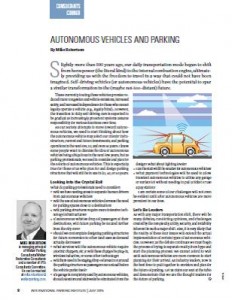Slightly more than 100 years ago, our daily transportation mode began to shift from horsepower (the literal kind) to the internal combustion engine, ultimately providing us with the freedom to travel in a way that could not have been imagined. Self-driving vehicles (or autonomous vehicles) have the potential to spur a similar transformation in the (maybe not-too-distant) future.
Those currently touting these vehicles promise reduced traffic congestion and vehicle emissions, increased safety, and increased independence for those who cannot legally operate a vehicle (e.g., legally blind). However, the transition to fully self-driving cars is expected to be gradual as increasingly proficient systems assume responsibility for various functions over time.
As our society attempts to move toward autonomous vehicles, we need to start thinking about how the autonomous vehicle may affect our clients’ infrastructure, current and future investments, and parking operations in the next five, 10, and even 50 years. I know some people want to dismiss the idea of autonomous vehicles being ubiquitous in the next few years, but as parking professionals, we need to consider and plan for the effects of autonomous vehicles. This is especially true for those of us who plan for and design parking structures that will still be in use in 30, 40, or 50 years.
Looking into the Crystal Ball
- What do parking professionals need to consider?
- Will we have nesting areas to separate human drivers from autonomous vehicles?
- Will the use of autonomous vehicles decrease the need for parking spaces close to a destination?
- Will parking structures require more intensive technology infrastructures?
- If autonomous vehicles drop off passengers at their destinations, will future parking be located farther from the city core?
- Should we contemplate designing parking structures for future conversion to other land uses as demand actually decreases?
- What services will the autonomous vehicle require (electric chargers, etc.)? Will these charges be plug-in, wireless inductive, or some other technology?
- Will there need to be staging/drop-off areas in or around the parking structure so passengers can unload before the vehicle parks itself?
- If a garage is completely used by autonomous vehicles, should elevators and stairwells be eliminated from the design? What about lighting levels?
- Can the stall width be smaller for autonomous vehicles?
- What payment technologies will be used to allow transient autonomous vehicles to utilize any garage or surface lot without needing to pull a ticket or use a pay station?
I am certain some of our challenges will not even be evident until after autonomous vehicles are more prevalent in our lives.
Let’s Be Leaders
As with any major transportation shift, there will be many debates, conflicting opinions, and challenges created by the complexity, utility, security, and reliability inherent in such a major shift. Also, it is very likely that the reality of these four issues will extend the actual implementation of certain types of autonomous vehicles. However, as the debate continues we must begin the process of trying to separate reality from hype and start the planning process. We cannot afford to wait until autonomous vehicles are more common to start planning for their arrival. As industry leaders, now is the best time to pull together to envision and plan for the future of parking. Let us claim our seat at the table and demonstrate that we are the thought leaders for the future of parking.
Mike Robertson is managing principal of Walker Parking Consultants/Walker Restoration Consultants and a member of IPI’s Consultants Committee. He can be reached at mike.robertson@walkerparking.com.
TPP-2015-07-Autonomous Vehicles and Parking

